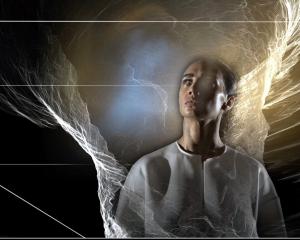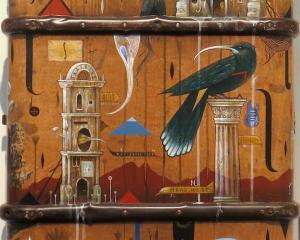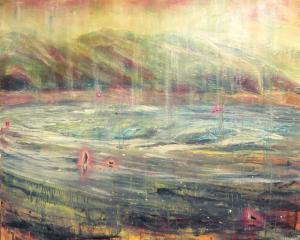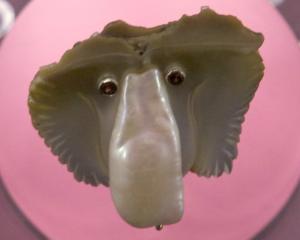> "... Or I'll dress you in mourning", Flynn Morris-Clarke (None Gallery)
Morris-Clarke has taken transsexual actress and Warhol "Factory" personality Candy Darling as an inspiration. Darling's very public exhibition of herself, her life and her transition from a he to a she has led to Morris-Clarke's transgressive, transsexual self-assessment in which he has repeatedly painted his self-portrait in drag.
The resulting images are as much an exercise in the artist's discovery of the hidden side of his (and everyone's) personality as an exercise in art. Yet as art, they also work well.
Morris-Clarke worked alongside a fashion consultant to obtain the "look" he required for each work, building up from photograph to watercolour study to final oil painting.
The finished pieces have a distinct three-dimensional quality, brought about by the mixing of two separate techniques. The skin was first painted smooth and flat, before the hair was added in exuberant brush strokes. The resulting images thus express something of the quality of flaming explosions of hidden personality escaping from behind a mask-like exterior.
> "Dot it down", Robert West, Annie Nevin, John Z. Robinson (Moray Gallery)
Robert West's prints continue to explore the artist's fascination with our desire to classify and link ideas and objects. Strands join, the nervous system becomes a railway map, and words are linked against amorphous backdrops. Two impressive monochromatic works are almost palaeontological, the prints becoming fossil flora in sheets of slate.
John Z. Robinson's work has turned in a different direction from his better-known landscapes and word games. Here, he is presenting small assemblages of images, with recurring motifs like the chair and vase juxtaposed in plain blocks of colour.
Several of these designs, such as the view of Dunedin's Chinese Garden, are reminiscent of the large brooches for which Robinson is also known.
In bold blocks of blackest ink, Annie Nevin has presented a series of views of Dunedin and South Canterbury, many of them tightly composed through windows in such a way as to imply that there is more to the scene in the hidden interiors. Images such as Looking for Logan Lake and a portrait of a relaxing local art dealer give an excellent sense of both time and place.
> "New works", Jim Cooper (Brett McDowell Gallery)
In the current exhibition, we see a transition in Cooper's work, one reflected in a change of his mental and physical surroundings between the hurried rush of time spent in Asia and a return to the more tranquil surroundings of Otago. This return was accompanied by a reassessment of the artist's earlier years in this place.
As a result, there are two distinct sections to this exhibition. One group stands close together - the psychedelically coloured friends and acquaintances of Cooper's friend "Moo the Daoist". The remaining figures stand as individuals, each on his or her own plinth. These are characters from Cooper's memory - his friends, his childhood - and, while they retain the gleefulness of the group, the tones are more muted and natural.
Accompanying this latter group are a number of charmingly strange domestic animals, which look as though they have stepped out of an Aardman claymation film. The works are joyful and inspire a big grin from the viewer.





![... we all become all of these things [installation view] (2025), by Megan Brady.](https://www.odt.co.nz/sites/default/files/styles/odt_landscape_small_related_stories/public/story/2025/03/1_we_all_become_all_of_thes.jpg?itok=nicA_yAm)


![Poipoia te Kākano [installation view]. Allison Beck, Megan Brady, Kate Stevens West, Jess...](https://www.odt.co.nz/sites/default/files/styles/odt_landscape_small_related_stories/public/story/2025/02/1_poipoia_te_k_kano.jpg?itok=ssJ8nxyx)



